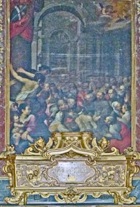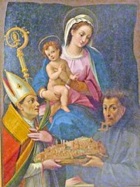
Detail of St Felix Altarpiece (17th century)
Pinacoteca Comunale
The Blessed Andrew da Spello was born in 1194 and became a priest before joining the Franciscan Order. He was thus one of the early companions of St Francis, whom he outlived by some 30 years. He died in Spello, probably in 1254.
The Blessed Andrew was recorded in ca. 1335 in the “Catalogus sanctorum Fratrum Minorum”, a long list of friars who were venerated as saints within the Franciscan Order. According to evidence presented in the process for his canonisation in 1625-30 (see below), “sanctus Andrea de Lac” was named in the statutes of Spello of 1360 as one of the town’s patron saints, whose feast was to be celebrated on 3rd June. The witnesses suggested that the non-Italian “de Lac” was a reference to the miracles of Blessed Andrew that connected him with water. Mario Sensi (below) suggests that these records of the saint were in fact 17th century additions to the surviving copy of these statutes.
In ca. 1390, the Blessed Andrew was documented as “Sanctus frater Andreas” in Bartholomew of Pisa's “De Conformitate Vitae Sancti Francisci ad Vitam Domini Jesu Christi” (On the conformity of the life of St Francis to the life of our Lord Jesus Christ). He is described there as having been a priest at Spello, who led a holy life and, after his death, performed miracles. He appeared again in “Lo Specchio de l’ Ordine Minore” (otherwise known as “La Franceschina”), which was published by the Observant Franciscan Giacomo Oddi of Perugia in ca. 1474. Brother Giacomo largely relied on the earlier material, but reflected his reformist leanings by asserting that Brother Andrew had been zealous in following the Franciscan Rule, particularly as it related to obedience.
Revival of the Cult
Fausto Gentile Donnola, the author of the “Istoria della Terra di Spello” (ca. 1620), described the rediscovery of the relics of the Blessed Andrew in Sant’ Andrea in 1594. (He had not witnessed these events but reported the account of someone who had). The friars of Sant’ Andrea asked their Provincial Minister to recover the relics of the Blessed Andrew, which they believed were buried near the pulpit. The site was marked by an ancient image of the Madonna and Child with SS John and Andrew, with a figure that they believed to be the Blessed Andrew below. The friars called for Ascensidonio Spacca, il Fantino (who was at work in the Oratorio di San Giacomo) to make a sketch of the image before it was destroyed in order to facilitate the recovery of the relics. An ancient coffin containing an entire skeleton was duly found.

-
✴a silver reliquary (1603) for the head of the Blessed Andrew (which is dated by inscription); [where is it now ?]
-
✴the rebuilding of the Altare del Beato Andrea and the gilded wooden reliquary that still adorns it in 1609; and
-
✴the altarpiece of a miracle of the Blessed Andrew reviving a man who has died, which is attributed to Cesare Sermei (before 1612).
Process for Canonisation
Bishop Lorenzo Castrucci of Spoleto initiated process for the canonisation of the Blessed Andrew began in 1625. Francesco Bongrazio da Gualdo Tadino, the Chancellor of the Commune, was given the task of collecting the necessary documents, which were submitted to the Sacred Congregation of Rites in 1627. In his evidence to the process, the historian Ludovico Jacobili cited the altarpiece above as evidence of the fact that the Blessed Andrew was known to have performed miracles during his life.
This phase of the process ended in 1630 without conclusion. His cult was confirmed in 1738, but the process for canonisation remains open.
Contest with St Felix

For reasons that are unclear, it was subsequently decided to adopt only one as the official patron of the town, and opinion was sharply divided. This is possibly reflected in two frescoes (ca. 1625) in San Ventura, which are attributed to Cesare Sermei:
-
✴St Felician preaching at Spello, on the right wall; and
-
✴a miracle of the Blessed Andrew, opposite.
The miracle in question is the same as the one depicted in Sant’ Andrea (illustrated above), and is set outside that church. The fact that St Felician (the patron saint of Foligno) is depicted opposite could well have constituted a claim that he rather than St Felix had been the true evangelist of Spello.
The matter was resolved in 1629, when Bishop Lorenzo Castrucci of Spoleto named St Felix as the sole patron saint of Spello.
Legend of Blessed Andrew
The legend of the Blessed Andrew was continually elaborated at least from the time of the rediscovery of his relics. This culminated in the publication in 1648 of the “Compendium ex liberculo fratris Thome de Spello” which was claimed to be a copy of a work Brother Thomas of Spello, a companion of the Blessed Andrew. According to this work:
-
✴Blessed Andrew joined the Franciscan Order in 1223 at the age of 29, after the death of his dependent mother, and became one of the first priests to do so;
-
✴he met Pope Gregory IX in Assisi at the time of the translation of the relics of St Francis in 1226 and, together with Brother Moricus, persuaded him to consecrate the high altar of San Lorenzo in their native town;
-
✴he attended a Provincial Chapter at Soria in Spain in 1233, during which he brought an end to a drought through prayer (a miracle that is attributed to Brother John Parenti, who became Minister General of Spain in 1219, in the Chronicle of the 24 Generals);
-
✴he was assigned to Reggio Emilia in 1239-43, and it was here that he performed the miracle (already known in art) of bringing a dead man back to life;
-
✴he was imprisoned in 1244 by followers of the ex-minister General, Brother Elias, because of his insistence on the literal observance of the Testament of St Francis, but was released when John of Parma became Minister General, (1247);
-
✴St Clare sent him to accompany Sister Pacifica de Guelfuccio d’ Assisi to reform the nuns at Santa Maria di Vallegloria, outside Spello, in 1248 and there he miraculously found a fresh water spring for them;
-
✴he then retired to the Eremo dei Carcere. outside Assisi, where he was visited in 1249 by the young Jesus who tested his obedience (a vision that is attributed to Andrew of Burgundy, a companion of Brother Giles, in the Chronicle of the 24 Generals);
-
✴he received the profession of Sister Cecilia di Gualtieri Cacciaguerra da Spello at Santa Maria di Vallegloria in 1250;
-
✴he arranged the transfer of Sant’ Andrea, Spello to the Francsicans in 1253 and became its guardian; and
-
✴he died on 3rd June, 1254, after which his sanctity was demonstrated by many miracles.
This account contains many historical inaccuracies. Mario Sensi (referenced below) attributes it to Francesco Olorini, a canon of San Lorenzo, who died in 1668.
Mario Sensi also attributes to Francesco Olorini chronicles from Santa Maria di Vallegloria that include the following information relating to the Blessed Andrew:
-
✴St Francis visited Santa Maria di Vallegloria in 1219, accompanied by other friars, including Brother Moricus of Spello;
-
✴following this visit, the Abbess Balvina d’ Offreduccio, who belonged to the Olorini family, decided to join the Order of Poor Ladies of San Damiano;
-
✴St Clare sent the Blessed Andrew to reform the nuns at Santa Maria di Vallegloria, with Sister Pacifica in 1248, and he miraculously found a fresh water spring for the nuns; and
-
✴Blessed Andrew received the profession of Sister Cecilia di Gualtieri Cacciaguerra da Spello at Santa Maria di Vallegloria in 1250.
This information contains at least three cases of mistaken identities:
-
✴Abbess Balvina has been confused with another Sister Balvina at San Damiano, who died in 1254. She was a relative of St Clare and might well have been called Balvina d’ Offreduccio, although it is highly unlikely that she belonged to the Olorini family.
-
✴Sister Pacifica, whom St Clare sent to reform Santa Maria di Vallegloria, was still a nun at San Damiano when she gave evidence in the process for the canonisation of St Clare in 1253. The chronicles probably confuse her with another Sister Pacifica, who was Abbess of Santa Maria di Vallegloria in 1248-54.
-
✴Sister Cecilia di Gualtieri Cacciaguerra da Spello, who also gave evidence in the process for the canonisation of St Clare in 1253, said that she had joined the order three years after St Clare (ie. in ca. 1215 rather than in 1250).
Read more:
A. Menestò (Ed.), “Il Beato Andrea Caccioli da Spello” (1997) Spoleto, particularly the contribution by Mario Sensi, “I Francescani a Spello” pp1-90
Return to the page on Saints of Spello.



